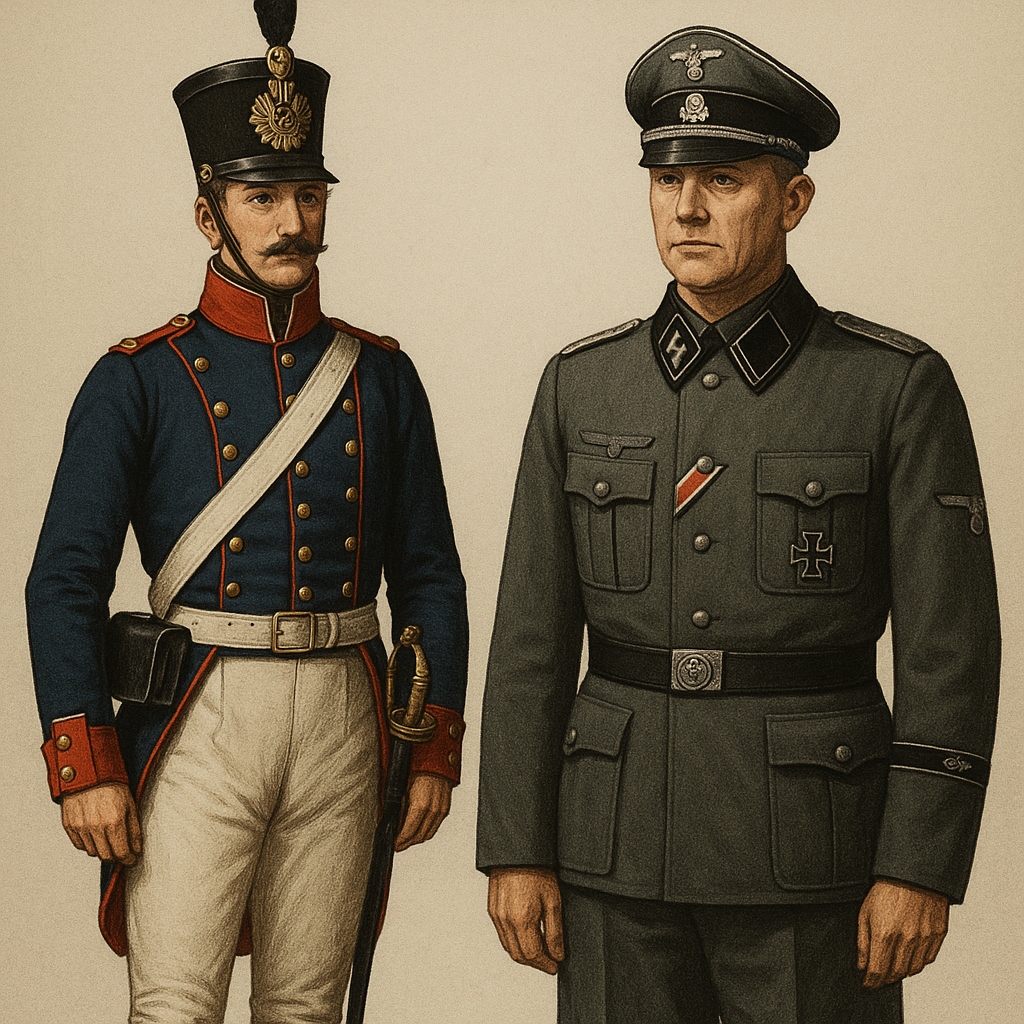
Prussian Uniform Details: Exploring Napoleonic Era and Waffen‑SS Accents
Published on Jul 02, 2025
1. Overview of Prussian Uniform Heritage
Prussia’s military tradition is renowned for discipline, precision, and visual uniformity. Prussian uniforms reflected the kingdom’s identity from Frederick the Great to Wilhelm II. Their evolution spanned bold colors, intricate piping, and indicators of rank and branch. These elements heavily influenced later German military styles, including the iconic Waffen‑SS.
2. Napoleonic Prussian Army Uniforms
2.1 Main Features & Colors
The Napoleonic Prussian Army uniform displayed a striking contrast: deep dark blue coats, often paired with white trousers. Lapels and cuffs were red, green, or yellow, indicating regimental identity. Brass or pewter buttons had unit numbers—reinforcing visibility and cohesion.
2.2 Rank & Branch Distinctions
- Officers wore gold braid epaulets and had fitted double-breasted coats.
- Enlisted men wore sewn-on shoulder straps and minimal trim.
- Infantry, grenadiers, hussars, and artillery units were easily identified by collar, cuff, and trouser stripe colors.
2.3 Common Regiments & Equipment
- Infantry regiments: 1st–20th colors varied; grenadier battalions often had miter caps.
- Hussars & cavalry: Lighter jackets with pelisse, fur-covered, and braiding.
- Field gear: Black leather belts, ammo pouches, and tall jackboots completed the ensemble.
3. Prussian Uniforms in Napoleonic Wars
During the Napoleonic Wars, evolving battlefield tactics triggered updates to Prussian uniforms Napoleonic Wars:
- Flexible coats for easier cavalry mounting
- Lighter gear for forced marches
- Regimental variations to signal new corps formations and alliances
Despite changes, the classic dark blue coat remained constant—an iconic identifier throughout the wars.
4. Transition to Waffen‑SS: German SS Patch & Colors
From Reichswehr to Wehrmacht and SS, Prussian military traditions continued to shape German uniforms. The Waffen‑SS, in particular, adapted earlier motifs for a modern, ideological army.
4.1 Evolution of SS Patches (German SS Patch)
The German SS patch—typically worn on the sleeve—denoted:
- Standarte (regiment) and Sturm (company) number
- Totenkopf (death’s head) collar collar tabs for honors units
- Field units often wore camouflage tunics, but sleeve patches remained leather or embroidered cloth, maintaining structure.
4.2 Waffen SS Colors & Their Meanings
The Waffen SS colors system followed long-standing German practice:
- Collar piping for individual branches (e.g., white for infantry, red for artillery)
- Shoulder boards and piping combined to indicate unit and commander rank.
- Waffen SS color standardization in 1935 helped uniform design better align with earlier Prussian models, blending tradition with modern utility.
4.3 Continuity from Prussian Discipline
Despite ideological shifts, the Waffen‑SS maintained:
- Structured appearance
- Rigorous tailoring
- Clear rank insignia delivery—hallmarks of the older Prussian tradition
5. Style, Materials & Reproduction Tips
For modern reenactors, collectors, and marketers of Prussian uniform details, authenticity is key:
- Fabrics: Use wool blends matching original rough-weave standards
- Buttons & badges: Pewter or brass with historically accurate motifs
- Collar/shoulder piping: Embroidered cotton or silk in the correct period colors
- Patch accuracy: Analyze photos and guides to replicate German SS patch variants
Tip: When shopping or producing custom gear, always cross-reference museum references and primary Uniform sources. This improves authenticity and SEO authority when linking to reputable resources.
6. SEO Strategy for “Prussian Uniform Details”
- Keyword usage
- Repeat “Prussian uniform details,” Napoleonic Prussian army uniforms, German SS patch, waffen ss colors naturally
- Semantically related terms
- Include "Prussian military," "Prussian regimental colors", “WWII Waffen‑SS insignia.”
- Headers & structure
- Use subheadings (H2, H3) with your keywords, e.g., H2: Napoleonic Prussian Army Uniforms
- Image integration and alt tags
- Add visuals (e.g., uniform plates) with alt text like “Napoleonic Prussian infantry uniform details.”
- Internal links
- Link to your pillar pages: Prussian Uniforms and Napoleonic Prussian Army Uniforms
- Link to subpages: German SS Patch, Waffen SS Colors, Prussian Uniforms Napoleonic Wars
- Metadata
- Ensure the meta title and description contain your target keywords
7. Final Thoughts & FAQs
Q: What makes Prussian uniforms iconic?
A: A combination of deep-blue wool, colored cuffs and collars denoting regiments, and consistent rank insignia created a unified, imposing visual identity.
Q: How accurate are modern Waffen‑SS patches?
A: Reproductions often vary, and collectors chase details like service years, unit numbers, and embroidery threads. It’s essential to consult original images.
Q: Can I blend Napoleonic and Waffen‑SS styles?
A: Purists avoid blending. Each era has distinct fabrics, cuts, insignia, and cultural context. Mixing won’t satisfy reenactors, historians, or searchers seeking clarity.
Conclusion
By diving deep into Prussian uniform details, from Napoleonic Prussian Army uniforms to German SS patches and Waffen SS colors, your site informs and engages a niche yet passionate audience. The richness of historical detail, combined with SEO best practices—keyword-driven headers, internal links to your pillar pages, and metadata—will boost your content’s visibility. Whether reenacting, collecting, or exploring military fashion history, this guide helps your users identify, compare, and appreciate the value of genuine Prussian military attire.
